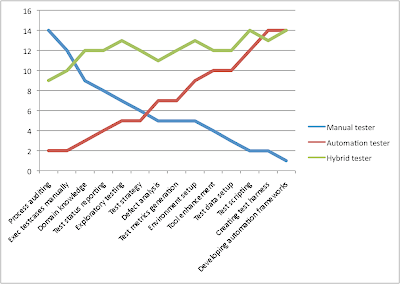In my testing career span of close to 7 years, i have come across various testers. Every tester has unique skill sets and things that motivate them. Based on the various tasks a tester has to do on a daily basis or during a project, I would like to categorise these testers into 3 types
Automated testers are technical testers who mainly deal with tools to help them test applications. They are given a set of test scenarios and all they need to do is automate these scenarios.
Hybrid testers are like superman. They are expected to do whatever is thrown at them and it is these types of testers that are in demand these days.
Now the interesting aspect is what motivates these testers in their day jobs. Lets take a look at this in the form of a graph where x-axis represents the various activities involved in the life of a tester and y -axis represents motivation levels.
As we can see, the motivation levels of manual testers for technically oriented tasks is fairly low and that of automated testers is high. It is the opposite for automated testers where their motivation is fairly low for tasks that are less technical.
However, the hybrid testers seem to be motivated consistently across all tasks and this is what makes them stand out amongst the herd of testers.
So in order to provide value to teams, testers should strive to become hybrid testers
- Manual tester
- Automated tester
- Hybrid tester
Automated testers are technical testers who mainly deal with tools to help them test applications. They are given a set of test scenarios and all they need to do is automate these scenarios.
Hybrid testers are like superman. They are expected to do whatever is thrown at them and it is these types of testers that are in demand these days.
Now the interesting aspect is what motivates these testers in their day jobs. Lets take a look at this in the form of a graph where x-axis represents the various activities involved in the life of a tester and y -axis represents motivation levels.
As we can see, the motivation levels of manual testers for technically oriented tasks is fairly low and that of automated testers is high. It is the opposite for automated testers where their motivation is fairly low for tasks that are less technical.
However, the hybrid testers seem to be motivated consistently across all tasks and this is what makes them stand out amongst the herd of testers.
So in order to provide value to teams, testers should strive to become hybrid testers

Comments
Post a Comment